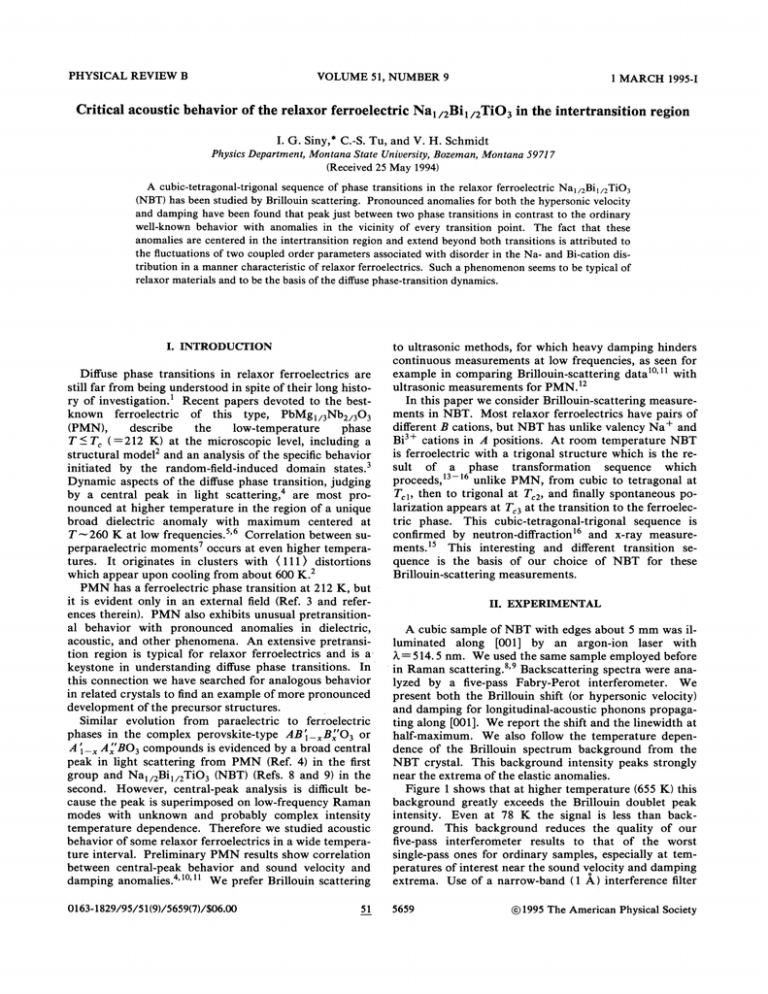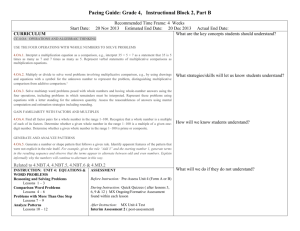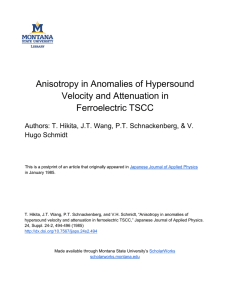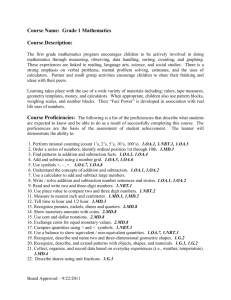Document 13556267
advertisement

PHYSICAL REVIEW B
VOLUME 51, NUMBER 9
1
MARCH 1995-I
Critical acoustic behavior of the relaxor ferroelectric Na, &28ii~2TiO3 in the intertransition
I. G. Siny, * C.-S. Tu,
region
and V. H. Schmidt
Montana State University, Bozeman, Montana 5971 7
(Received 25 May 1994)
Physics Department,
A cubic-tetragonal-trigonal
sequence of phase transitions in the relaxor ferroelectric Na& &~Bi ~&Ti03
(NBT) has been studied by Brillouin scattering. Pronounced anomalies for both the hypersonic velocity
and damping have been found that peak just between two phase transitions in contrast to the ordinary
well-known behavior with anomalies in the vicinity of every transition point. The fact that these
anomalies are centered in the intertransition region and extend beyond both transitions is attributed to
the fluctuations of two coupled order parameters associated with disorder in the Na- and Bi-cation distribution in a manner characteristic of relaxor ferroelectrics. Such a phenomenon seems to be typical of
relaxor materials and to be the basis of the difFuse phase-transition dynamics.
&
I. INTRODUCTION
to ultrasonic methods, for which heavy damping hinders
continuous measurements at low frequencies, as seen for
with
example in comparing Brillouin-scattering data'
ultrasonic measurements for PMN. '
In this paper we consider Brillouin-scattering measurements in NBT. Most relaxor ferroelectrics have pairs of
different B cations, but NBT has unlike valency Na+ and
Bi + cations in A positions. At room temperature NBT
is ferroelectric with a trigonal structure which is the result
of a phase transformation
which
sequence
proceeds, ' ' unlike PMN, from cubic to tetragonal at
T, j, then to trigonal at T, 2, and finally spontaneous polarization appears at T, 3 at the transition to the ferroelectric phase. This cubic-tetragonal-trigonal
sequence is
confirmed by neutron-difFraction'
and x-ray measurements. '
This interesting and difFerent transition sequence is the basis of our choice of NBT for these
Brillouin-scattering measurements.
'"
Diffuse phase transitions in relaxor ferroelectrics are
still far from being understood in spite of their long histo' Recent papers devoted to the bestry of investigation.
known
ferroelectric of this type, PbMg &/3Nb2/303
describe
the
low-temperature
(PMN),
phase
(=212 K) at the microscopic level, including a
structural model and an analysis of the specific behavior
initiated by the random-field-induced
domain states.
Dynamic aspects of the diffuse phase transition, judging
are most proby a central peak in light scattering,
nounced at higher temperature in the region of a unique
broad dielectric anomaly with maximum centered at
T-260 K at low frequencies. ' Correlation between superparaelectric moments occurs at even higher temperatures. It originates in clusters with ( 111 ) distortions
which appear upon cooling from about 600 K.
PMN has a ferroelectric phase transition at 212 K, but
it is evident only in an external field (Ref. 3 and references therein). PMN also exhibits unusual pretransitional behavior with pronounced anomalies in dielectric,
acoustic, and other phenomena. An extensive pretransition region is typical for relaxor ferroelectrics and is a
In
difFuse phase transitions.
keystone in understanding
this connection we have searched for analogous behavior
in related crystals to find an example of more pronounced
development of the precursor structures.
Similar evolution from paraelectric to ferroelectric
AB
B„"03 or
phases in the complex perovskite-type
A
„A "BO3 compounds is evidenced by a broad central
peak in light scattering from PMN (Ref. 4) in the first
group and Nai &2Bi, &@Ti03 (NBT) (Refs. 8 and 9) in the
second. However, central-peak analysis is di5cult because the peak is superimposed on low-frequency Raman
modes with unknown and probably complex intensity
temperature dependence. Therefore we studied acoustic
behavior of some relaxor ferroelectrics in a wide temperature interval. Preliminary PMN results show correlation
between central-peak behavior and sound velocity and
We prefer Brillouin scattering
damping anomalies.
A cubic sample of NBT with edges about 5 mm was ilalong [001] by an argon-ion laser with
X=514.5 nm. We used the same sample employed before
in Raman scattering. ' Backscattering spectra were analyzed by a five-pass Fabry-Perot interferometer.
We
present both the Brillouin shift (or hypersonic velocity)
and damping for longitudinal-acoustic
phonons propagating along [001]. We report the shift and the linewidth at
half-maximum.
We also follow the temperature dependence of the Brillouin spectrum background from the
NBT crystal. This background intensity peaks strongly
near the extrema of the elastic anomalies.
Figure 1 shows that at higher temperature (655 K) this
background greatly exceeds the Brillouin doublet peak
intensity. Even at 78 K the signal is less than background. This background reduces the quality of our
five-pass interferometer
results to that of the worst
single-pass ones for ordinary samples, especially at temperatures of interest near the sound velocity and damping
extrema. Use of a narrow-band (1 A) interference filter
0163-1829/95/51(9)/5659(7)/$06. 00
5659
T(T,
&
&
' '"
51
II. EXPERIMENTAL
luminated
1995
The American Physical Society
I. G. SINY, C.-S. TU,
AND V. H. SCHMIDT
51
400
200
655 K
5000—
I
N
(3
l
I
I
I
I
I
t
i
56—
600
»
I
800
I
&(
T,2
Tm
(0
C'.
C3
O
4000—
„rI
52—
I
CO
CL
78
200—
I
b
~
~
~
~
100—
II
It
P
~ ~
~~
~~
~
~
~ h~
oe+g,
I
3
~ ~ ~
Qo ~
E
E
X
~
Cll
I~)I
II/I
4
K
I
IIIIIAI
1
I
I
I
I
I
I
I
100
200
I
300
400
O
Dl
O
!
4000—
~
~la
CO
CHANNELS
FIG. 1. Two Brillouin spectra at
different temperatures are
shown to illustrate the experimental conditions to measure three
values: the frequency shift, the linewidth at half maximum, and
the intensity of the background. The free spectral ranges of the
interferometer are 30.20 GHz for T=655 K and 34.62 GHz for
T=78 K.
did not improve the situation radically. Probably a very
strong central peak is the main origin of this background.
Although this background causes significant spreads in
our shift and linewidth values, we obtained good reliability of the main anomalies (a dip in sound velocity and a
peak in sound damping, Fig. 2).
We used the green line of our argon-ion laser and our
NBT sample is yellow-green at room temperature, so we
were concerned about green light absorption at higher
sample temperatures.
However, the laser beam intensity
exciting the crystal was not significantly reduced even at
the highest temperatures. In any case, a shift of the fundamental absorption edge upon heating mostly affects inOur shift and linewidth measuretensity measurements.
ments covered too small a frequency range to be affected,
except in very special cases. We carried out only qualitative analysis of the background intensity. Qualitatively
similar behavior was found for both the background intensity (a green laser) and the central-peak intensity in
Raman scattering (a red laser ' ). Accordingly we are
sure that our Brillouin shift and linewidth data are
correct.
The ferroelastic phase transition at T„reduces the cubic symmetry to tetragonal, but the a/c cell parameter
ratio changes only slightly, going abruptly to a/c =0.999
at T„and decreasing to 0.998 on cooling down to T, 2. '
Because of this small change, we observed no splitting or
even broadening of the Brillouin components from the
ferroelastic domain structure, even though such domains
were clearly seen under a microscope. ' Accordingly we
expect that application of uniaxial pressure to create a
single ferroelastic domain would not have affected our
spectra significantly.
The tetragonal-trigonal symmetry change and the tran-
CQ
O
C:
~
I
C
~
2000—
~
~
~
I
p
)
V)
aa
4
I
0
I
I
I
I
I
I
I
I
I
I
I
i
i
i
i
200
400
600
800
Temperature
I
(K)
FIG. 2. Temperature dependence of different characteristics
in NBT: {a) Brillouin shift of the longitudinal acoustic phonons
vs T; (b) Linewidth of Brillouin components at half maximum
(or damping) vs T; the instrumental broadening was subtracted;
(c) Intensity of the background in the Brillouin spectra vs T.
sitions to the antiferro- and ferroelectric states also do
not affect the Brillouin spectrum. This implies either that
the antiferro- and ferroelectric microdomains are small
compared to the optical wavelength, or that these distortions also are too small to affect the Brillouin splitting
and linewidth. In the latter case, application of an electric field to create a single ferroelectric domain would not
have affected the Brillouin spectrum. In the former case,
a shift might have been observable, but such a large field
could have drastically altered the phase diagram. For instance, in PMN an anomaly in ac dielectric permittivity
corresponding to a ferroelectric transition appears only
upon simultaneous application of a large dc electric field
(Ref. 3 and references therein).
The acoustic behavior of NBT thus remains pseudocubic even at low temperatures, where the velocity and
damping recover the values they had in the paraphase.
Such pseudocubic behavior in lower-symmetry phases is
typical for relaxor materials. For instance, the ferroelectric phase of PMN has regions with trigonal distortions
but the acoustic properties can be described by a cubic
set of elastic constants (Ref. 10 and references therein).
III. COMPARISON OF BRILLOUIN
AND OTHER EARLIER NBT RESULTS
Figures 2(a) and 2(b) show, respectively, the temperature dependence of shift and linewidth for the Brillouin
components in NBT and reveal a huge dip in sound ve-
CRITICAL ACOUSTIC BEHAVIOR OF THE RELAXOR. . .
locity and an unprecedented damping peak. Figure 2(c)
presents a very large background intensity peaking in the
same temperature range. To analyze these unusual elastic and background anomalies we superimpose these results on a transition sequence scheme indicated by results
from the literature.
Neutron-diffractio data' indicate that NBT crystals
possess two instabilities at different points in the Brillouin
zone. A first-order phase transition occurs at T, = 820 K
from a cubic paraphase to a tetragonal ferroelastic phase.
The tetragonal distortion corresponds to an irreducible
representation at the M point of the cubic phase Brillouin
zone. The appearance, development and disappearance
of the M-point superlattice rejections observed in neutron diffraction' is illustrated in Fig. 3.
The next transition which is nominally at T,2=610 K
(Ref. 12) is to a trigonal phase. The trigonal structure is
not a subgroup of the tetragonal structure, but its distortion corresponds to an irreducible representation at the R
point of the cubic phase Brillouin zone. The temperature
given as T,z in older publications is 593 K, which is
shown as the limit of the tetragonal phase in Fig. 3 and
which is the point of onset of phase coexistence in heating runs. There is a sharp cusp at 640 K in the M-point
neutron re6ection intensity in heating runs, which signals
of the phase transition.
All our
the completion
Brillouin-scattering measurements were carried out during heating runs.
The neutron-scattering
data indicate that the phase
transitions at T, and T, 2 are initiated by some irreducible representations at the M and R points of the cubic
&
&
!
I
I
I
I
I
I
I
I
I
I
Phases
IV
III
I
I
I
I
I
phase Brillouin zone, respectively. ' It is well-known
that in both these cases the anomalies for longitudinalacoustic phonons are described by Qg u-type coupling,
squared in order parameter and linear in strain, where Q
is an electrostriction coefficient. ' However, neither the
steplike anomaly for sound velocity nor the LandauKhalatnikov maximum for damping could be observed
with certainty in the vicinities of T„and T, 2 which are
located on opposite sides of an extensive dip in sound velocity and a broad damping peak. The velocity dip and
damping peak look like reAections of each other in a horizontal mirror plane [Figs. 2(a) and 2(b)]. The usual vemaximum at phase
locity step and Landau-Khalatnikov
transitions do not appear as reAections of each other.
Dielectric measurements by ourselves and others give
another sequence of anomalies which correspond only
The dielectric
partially to the structural instabilities.
behavior of NBT is summarized in our recent paper. '
The lowest-temperature
permittivity
anomaly is small
and corresponds to a third transition, in a region centered
at T, 3=473 K where the remanent polarization disappears. This ferroelectric transition is far below the
nearest structural instability point, T,2.
Another dielectric anomaly was found in our NBT
sample near 640 K (Fig. 4) and had been seen by others,
with some spread of reported permittivity peak temperatures (Ref. 18 and references therein). This anomaly has
a characteristic cusp shape similar to that of the M-point
reAection intensity which also cusps at 640 K, so this
transianomaly may result from the tetragonal-trigonal
tion centered at T, 2. From T, 2 down to T, 3 there is an
enigmatic phase in which some workers report double
hysteresis loops typical of antiferroelectric behavior, but
others deny that an antiferroelectric phase exists (see Ref.
18 for discussion and other references).
Our largest dielectric hump was found near the cubictetragonal transition temperature T, and was attributed
&
I
I
5661
I
I
Trigonal
Symmetry
ITetragonal
N
CUbtc
I
I
I
I
I
I
I
I
I
(3
E
E
~
~
3—
a
~ e
I
~
~
6$
I+
~
~y ~o
g
J
~
~O ~
Opy
T
I
0
I
I
I
~g
I
~
.
I
CU
(0
(I
Q)
&
R
l@g
M
~
—3000
Ch
I
I
200
'
'
'
'
I
400
'
Jo( oi '
" i
600
'
E
0~
I
—2000
800
0)
CL
O
U
Temperature
—1000
(K)
FIG. 3. Intensity of the superlattice rejections from M and E.
points of the cubic Brillouin zone obtained in neutron-scattering
measurements (Ref. 16) vs T to show the range of phase coexistence (shaded region). The phase sequence in NBT is shown at
the top; I: paraelectric and paraelastic, II: ferroelastic, III: antiferroelectric (?), IV: ferroelectric. The corresponding crystal
symmetries are shown in the rniddle. All data were obtained on
heating runs.
I
0
I
I
I
I
I
I
I
I
I
I
I
l
[
i
i
i
200
400
600
800
Temperature
Cl
I
(K)
FIG. 4. A comparison of the dielectric maximum in NBT
measured at 100 kHz (b) with the behavior of acoustic-phonon
(a). The dashed line indicates the temperature
damping
difference between dielectric and acoustic damping maxima.
I. G. SINY, C.-S. TU, AND V. H. SCHMIDT
5662
clusters in the tetragonal phase. '
This hump was observed from 20 Hz to its disappearance
above 10 kHz with corresponding peak positions ranging
from 720 to 870 K. No particular anomaly was observed
right at the first-order transition temperature T„=820 K
reported by Vakhrushev et al. ' Similar dielectric permittivity humps in other perovskite crystals and ceramics
have been attributed to partial blocking of current flow
'
Accordingly, the deby surface layers or electrodes. '
gree and nature of connection of this special highrelaxation behavior with the ferroelastic
temperature
phase transition is uncertain.
To summarize the comparison of our Brillouin results
with neutron-diffraction and dielectric measurements, the
broad anomalies we observed in sound velocity, damping,
and background do not correspond to any of the transitions indicated by neutron and dielectric results. The
closest correspondence is a very rough resemblance of the
background intensity in Fig. 2(c) to the neutron M-point
reflection intensity
in Fig. 3. The comparison
of
linewidth with permittivity in Fig. 4 shows that the peak
values are not far apart, but the linewidth peak is an order of magnitude broader and so it cannot reasonably be
attributed to the transition at T, 2. To explain these
broad anomalies, we employ comparisons with other systems as described in Sec. IV.
to superparaelectric
IV. DISCUSSION OF NBT IN RELATION
TO OTHER SYSTEMS
Recent papers show that relaxor ferroelectrics provide
a unique opportunity for observing fluctuation contributions, ' ' which we believe are responsible for the broad
anomalies we observed in Brillouin scattering from NBT.
For instance, the diffuseness of the ferroelectric phase
transition in PMN was attributed
to random-fieldinduced clusters originating from charged compositional
fluctuations.
In NBT such fluctuations could originate
in randomly placed Na+ and Bi + cations and we expect
that they contribute to the acoustic anomalies also. Figure 2(b) shows considerable anomalous damping gradually developing far above T, which can be reasonably attributed to fluctuations.
The usual Landau theory is not valid if large fluctuations exist, so we would not expect to find separately the
relaxation portion of the acoustic anomaly which should
be a sharp anomaly near the phase transition. For example, it was shown for critical ultrasonic attenuation at the
liquid-helium
A, point
that inescapable mixing of the
Landau-Khalatnikov
(or order parameter) and fluctuation contributions occurs in this system which has large
fluctuations. ' A similar "hybridization" may prevent us
from observing relaxation contributions of the usual form
as seen in many ferroelectrics and ferroelastics even in
the presence of the considerable dispersion characteristic
of Brillouin scattering in these materials. ' '
The "hybridization" describes for the helium system '
near the A. point should occur in NBT near two transitions, from the tetragonal phase to the cubic phase at T,
and to the trigonal phase at T,2. However, a linear superposition of two anomalies at the T„and T, z phase
&
&
transitions cannot fit our data. The velocity minimum
and damping
maximum
extremes both occur near
T,„„=670K which is between T, and T,2 and closer to
T,2. This leads us to suggest an interaction of fluctuations. Each type of fluctuation contributes to acoustic
anomalies with the same g u-type coupling between the
fluctuating order parameter and strain.
In what ways is the hybridization in NBT similar to
that in liquid helium, and in what ways does it differ? In
liquid helium, and other pure systems with second-order
transitions, as one goes away from the critical point there
is a dominant phase (possibly broken up into domains
large enough so they do not affect Brillouin scattering
significantly) which near the critical point has small temporal fiuctuations of the other phase(s) not restricted to
any particular spatial regions. These fluctuations are
only significant in the near vicinity of the transition.
In NBT we do not have a pure system because disordered placement of unlike-valence cations leads to electric and elastic fields. This disorder is quenched, at least
for times shorter than the conductivity relaxation time.
This disorder and the resulting fields prevent buildup of
large domains. Instead, there are microdomains or superparaelectric clusters whose boundaries fluctuate in
time, and which may rearrange completely in a time
longer than the conductivity relaxation time (if the conductivity is due to these cations). If such complete rearrangement occurs, it is likely that it occurs throughout
the tetragonal phase temperature range, with partial rearrangement extending into the cubic and trigonal phases
where tetragonal clusters are expected to persist. Then
the "pure fluctuation" state which in a pure system exists
only exactly at T„exists in this impure system over a
wide temperature range, with greater correlation length
and longer time constant than for typical fluctuations.
To our knowledge, no theory deals explicitly with such
impure-system fluctuations. Perhaps the closest analogy
is the behavior right at T, for a pure system with a
second-order phase transition. We have provided here a
qualitative discussion of the NBT behavior based on this
analogy. This behavior can be expected to exhibit dispersion effects. Figure 4 compares temperature dependences
for the largest frequency-independent
dielectric anomaly
(lower curve) with that for hypersonic damping (upper
curve). As discussed above, the position of this dielectric
maximum near 640 K is probably determined by competition of coupled order parameters initiating different
structural instabilities.
The hypersonic damping maximum peak near 670 K is probably connected with fluctuation of these coupled order parameters. The shift of
damping maximum (measurements at about 5 X 10' Hz)
relative to the dielectric anomaly (measurements at 10
Hz) is clearly seen. The shift may be due to the frequency
dependence of fluctuations coupling electrostrictively to
strain. This behavior is very similar to that in PMN
which also shows a shift between the dielectric maximum ' ' and the hypersonic damping peak. '
Fluctuations of the coupled order parameters or hybridized fluctuations manifest themselves in the spectra of
low-frequency light scattering also. A preliminary indication of increased central-peak intensity between T,
&
"
&
CRITICAL ACOUSTIC BEHAVIOR OF THE RELAXOR. . .
and T, 2 was obtained in the Raman-scattering
study. '
In the present work we followed the behavior of the background in the Brillouin spectra which consist of the scattered light transmitted through an interference filter of
1-A half-width together with the Brillouin components.
This background corresponds to the peak intensity of the
central component if there is only one broad central
peak as suggested by the Raman spectra. ' Figure 2(c)
shows three special features of this background. The major feature is the broad background peak, which is qualitatively similar to the broad linewidth peak in Fig. 2(b)
and the broad Brillouin shift dip in Fig. 2(a). The second
feature is the background increase when approaching T,2
from below and T, from above, which is comparable to
the evolution of both the central peak in Raman scattering ' and overdamped soft modes detected in neutron
scattering. ' However, these effects are small in comparison with the dominant anomaly in low-frequency light
scattering between T„and T, 2. The third feature is the
"sloping mesa" between 593 and 640 K which corresponds nearly to the tetragonal and trigonal phase coexistence region. The discontinuities characterizing this
feature are not seen in the acoustic anomalies in Figs. 2(a)
and 2(b).
The shaded region in Fig. 3 shows the coexistence
range of the R- and M-point superlattice reAections,
which corresponds to the trigonal and tetragonal phases.
The acoustic anomalies have no obvious relation to this
coexistence region centered near 600 K because their extrema [Figs. 2(a) and 2(b)] are significantly shifted to
Although the neutron measurehigher temperatures.
ments can separate information from different points in
the Brillouin zone so superlattice structures of different
(Fig. 3),
types (M and R) were studied independently'
the light-scattering spectra show an integral response.
We have found an obvious correlation of the neutronwith our Brillouin background inscattering intensity'
tensity and the central peak in Raman scattering ' as T„
is approached from above. However, this effect in light
scattering is weak enough in comparison with the increase of the background between T„and T, 2 so that we
can clearly define it as a critical process. We have no
data now on the location in the Brillouin zone to which
this critical process corresponds. It may be at some other
point than the M or R points, in partial analogy with the
situation in proton glass discussed below.
in
revealed
fluctuations
Brillouin
scattering
which
Rb& „(NH&), HzPO~ (RADP) mixed crystals '
in the 0. 22 & x & 0. 74 "proton glass" range exhibit
features qualitatively different from both the ferroelectric
(x =0) or antiferroelectric (x = I ) pure substances. Also,
neutron studies revealed
a growth of short-range corre1ations upon cooling in the deuter ated isomorph of
RADP. These fiuctuations were neither ferroelectric (I
point at Brillouin zone center) nor antiferroelectric (Z
Instead, a characteristic
point at the zone boundary).
response in the neutron scattering appeared at wave vectors qX on the X lines connecting the I point to the Z
point. Perhaps, in partial analogy to these results, neutron scattering in the correct geometry in NBT will
someday show that the fluctuations do not occur at a
&
5663
Brillouin-zone point corresponding to its ordered phase.
Both proton glass and NBT have competing interactions caused by random cation placement. In proton
glass the competing ferroelectric and antiferroelectric interactions provide local order which is neither ferroelectric and antiferroelectric. This order can be characterorder parameter (at least
ized by an Edwards-Anderson
on a short-time scale). This order parameter provides a
Landau-Khalatnikov
term as the main contribution for
the acoustic anomalies of the longitudinal phonons in
RADP, ' compared to which the contribution of dynamic fluctuations was negligible.
In NBT the tetragonal and trigonal ordering tendencies are not completely frustrated by the random cation
placement. However, the strong short-range interactions
from the random ion placement compete with the interactions causing the transitions, giving the relaxor
state, in partial analogy to the proton glass state in the
RADP family. In contrast to RADP, there is strong evidence for critical behavior in NBT resulting from the
dominance of the fluctuation contribution to the acoustic
anomalies.
Returning now to the unusual, possible antiferroelectric, region between T,2 and T, 3, we emphasized recently' the similarity in the behavior of NBT and other comand
like
PbCo i &zW»203
perovskites
plex
PbYb»2Ta»203. A theoretical interpretation recently
for the polarization response of crystals with
appeared
structural and ferroelectric instabilities. A simple model
with two coupled structural and ferroelectric order parameters "shifts" the main dielectric anomaly from the
one.
structural
the
transition
to
ferroelectric
PbCo0 5WQ 503 is considered as the clearest example. We
cannot apply this model directly because NBT has two
structural instabilities rather than one. However, the
above "shift" makes it seem likely that the dielectric
response of NBT is modified by the coupling between
different order parameters. This may be the reason why
the dielectric anomaly near 640 K has no obvious connection with any particular instability.
Comparing results for NBT and other relaxor materials, we would like to emphasize the importance of the
short-range random-ion-caused interactions in promoting
similar relaxor behavior in both crystals. For instance,
the hypersonic response of PMN is very similar to that of
NBT. Both exhibit a broad sound velocity dip and a corThus we exresponding broad damping maximum.
pect the relaxor state in PMN to be the result of competing interactions also. However, in PMN the ordering
tendencies are completely frustrated under normal conditions. Only in an external electric field did a ferroelectric
anomaly of the dielectric constant appear at T, -212 K
which corresponds to the lower transition with respect to
In Pbln, &zNb, &z03 (PIN), the upper
the relaxor state. '
antiferroelectric phase transition occurs only in samples
with an ordered distribution of the In and Nb cations.
It may be that the dynamics of partly disordered PIN will
be similar to that in NBT. Hence PIN is a very desirable
object for future Brillouin or ultrasonic measurements.
Numerous perovskite structure compounds have a sucMost of them have large
cession of phase transitions.
' '"
I. G. SINY, C.-S. TU, AND V. H. SCHMIDT
5664
contributions
evidenced by broad central
fluctuation
peaks in light scattering, (i.e., in BaTi03 and KNb03)
(Ref. 30) or by display of precursor order in the behavior
of di8'erent properties (i.e. , in Raman spectra). ' However, as far as we know, no one has shown acoustic
anomalies to be shifted to an intertransition region. NBT
does show formally a sequence of perovskite-type phase
transitions with symmetry reduction but phenomenologically it is aftiliated with the relaxor ferroelectrics. The
competing but interacting fluctuations in NBT manifest
of acoustic
themselves
clearly in the appearance
Such behavior
anomalies between phase transitions.
seems to be characteristic of relaxor materials even if the
"surrounding"
The
phase transitions are frustrated.
charged compositional heterogeneity provides a fruitful
ground for development and coupling of the competing
order parameters.
V. CONCLUSIONS
We have shown that the relaxor ferroelectric NBT exhibits correlated anomalies in the sound velocity and
damping as well as in the background intensity. The
latter anomaly is connected qualitatively with the central
peak in light scattering. Figures 2(a) —2(c) show that
these anomalous behaviors extend far above T„due to
Auctuations, as for many other perovskite phase transiof critical
tions. However, a simple superposition
anomalies at T„and T, 2 does not explain the experimental dependences. There may be special mixed Auctuations
or fluctuations of the coupled order parameters (which
we also call "hybridized" fluctuations) with a characteristic extremal response at a temperature that has no direct
'Present address: A. F. Ioffe Physical Technical Institute, Russian Academy of Sciences, St. Petersburg 194021, Russia.
G. A. Smolensky and V. A. Isupov, Dokl. Akad. Nauk SSSR
97, 653 (1954); G. A. Smolensky, J. Phys. Soc. Jpn. 28, Suppl.
26 (1970).
N. de Mathan, E. Husson, G. Calvarin, J. R. Gavarri, A. W.
Hewat, and A. Morell, J. Phys. Condens. Matter 3, 8159
(1991);E. Husson, M. Chuff, and A. Morell, Mater. Res. Bull.
24, 201 (1989).
V. Westphal, W. Kleeman, and M. D. Glinchuk, Phys. Rev.
Lett. 68, 847 (1992).
4S. D. Prokhorova and S. G. Lushnikov, Ferroelectrics 90, 187
(1989).
5G. A. Smolensky, V. A. Isupov, A. A. Agranovskaya, and S. N.
Popov, Fiz. Tverd. Tela (Leningrad) 2, 2906 (1961) [Sov.
Phys. Solid State 2, 2584 (1961)].
6D. Viehland, M. Wuttig, and L. E. Cross, Ferroelectrics 120,
71 (1991).
7L. E. Cross, Ferroelectrics 76, 241 (1987).
I. G. Siny, T. A. Smirnova, and T. V. Kruzina, Sov. Phys. Solid
State 33, 61 (1991).
I. G. Siny, T. A. Smirnova, and T. V. Kruzina, Ferroelectrics
124, 207 (1991).
R. Laiho, S. G. Lushnikov, S. D. Prokhorova, and I. G. Siny,
Sov. Phys. Solid State 32, 2024 (1990).
R. Laiho, S. G. Lushnikov, and I. G. Siny, Ferroelectrics 125,
493 (1992).
51
relation to the Landau-like behavior of the order parameters obtained from neutron scattering. We illustrate in
Fig. 3 the absence of a simple relation between the
anomalies discussed above and "the region of coexistence
of two independent phases.
The main conclusion of this paper concerns the existence of acoustic anomalies above the temperatures of
the two frequency-independent
dielectric anomalies in
NBT. This work continues related investigations of
in which acoustic anomalies were found near
PMN, '
290 K, above the characteristic relaxor dielectric peak
near 260 K and far above the frustrated ferroelectric transition at 212 K. In both crystals very similar anomalies
were found in the sound velocity and damping far above
the temperatures at which the remanent polarization or
the ferroelectric state disappear. The relaxor ferroelectric states in both NBT and PMN seen to be final results
of slightly different temperature evolution in which
unusual but similar acoustic anomalies were found as a
common feature in these two different types of relaxor
ferroelectrics.
"'
'"
ACKNOWLEDGMENTS
The authors are grateful to T. V. Kruzina for singlecrystal growth. One of us (I.G.S.) wishes to thank the
Physics Department for financial support and for kind
hospitality during a long stay at the Montana State University. I.G.S. greatly appreciates the financial support
through an NRC CAST Grant. This work was supported by NSF Grant No. DMR-9017429.
G. A. Smolensky, N. K. Yushin, and S. I. Smirnov, Fiz.
Tverd. Tela (Leningrad) 27, 801 (1985) [Sov. Phys. Solid State
27, 492 (1985)].
' I. P. Pronin, N. N. Parfenova, N. V. Zaitseva, V. A. Isupov,
and G. A. Smolensky, Fiz. Tverd. Tela (Leningrad) 24, 1860
(1982) [Sov. Phys. Solid State 24, 1060 (1982)].
~4V. A. Isupov, I. P. Pronin, and T. V. Kruzina, Ferroelectrics
Lett. 2, 205 (1984); V. A. Isupov and T. V. Kruzina, Bull.
Acad. Sci. USSR, Phys. Ser. 47, 194 (1983).
J. A. Zvirgzds, P. P. Kapostins, J. V. Zvirgzde, and T. V.
Kruzina, Ferroelectrics 40, 75 (1982).
S. B. Vakhrushev, B. E. Kvyatkovsky, R. S. Malysheva, N. M.
E. L. Plachenova, and P. P. Syrnikov,
Okuneva,
Kristallografiya 34, 154 (1989) [Sov. Phys. Crystallogr. 34, 89
(1989)].
B. Luthi
and W. Rehwald, in Structural Phase Transition I,
edited by K. A. Muller and H. Thomas, Topics in Current
Physics, Vol. 23 (Springer, Berlin, 1981), p. 131.
C.-S. Tu, I. G. Siny, and V. H. Schmidt, Phys. Rev. B 49,
11 550 (1994).
R. Stumpe, D. Wagner, and D. Bauerle, Phys. Status Solidi A
75, 143 (1983).
O. Bidault, P. Goux, M. Kchikech, M. Belkaoumi, and M.
Maglione, Phys. Rev. B 49, 7868 (1994).
R. A. Ferrell and J. K. Bhattacharjee, Phys. Rev. B 23, 2434
(1981).
H. Z. Cummins, in Light Scattering Near Phase Transitions,
CRITICAL ACOUSTIC BEHAVIOR OF THE RELAXOR. . .
51
edited by H. Z. Cummins and A. P. Levanyuk (NorthHolland, Amsterdam, 1983), p. 359.
E. Courtens, F. Huard, and R. Vacher, Phys. Rev. Lett. 55,
772 (1985).
E. Courtens, R. Vacher, and Y. Dagorn, Phys. Rev. B 36, 318
(1987).
5665
H. Amdt, F. Sauerbier, G. Schmidt, and L. A. Shebanov, Ferroelectrics 79, 145 (1988).
P. Groves, Phase Trans. 6, 43 {1985).
~9M. E. Lines and A. M. Glass, Principles and Applications of
I'erroelectrics
and Related
Materials
(Clarendon,
Oxford,
1977).
P. Xhonneux, E. Courtens, and H. Grimm, Phys. Rev. B 38,
J. P. Sokoloff, L. L. Chase,
9331 (1988).
E. V. Balashova and A. K. Tagantsev, Phys. Rev. B 48, 9979
(1993).
{1988).
A. D. Bruce, W. Taylor, and A. F. Murray,
(1980).
and
D. Rytz, Phys. Rev. B 38, 597
J. Phys. C 13, 483







